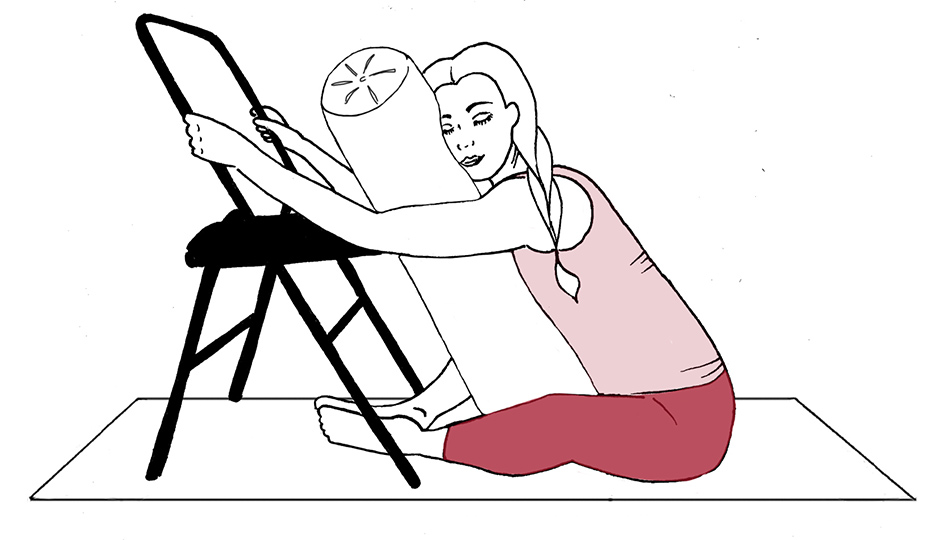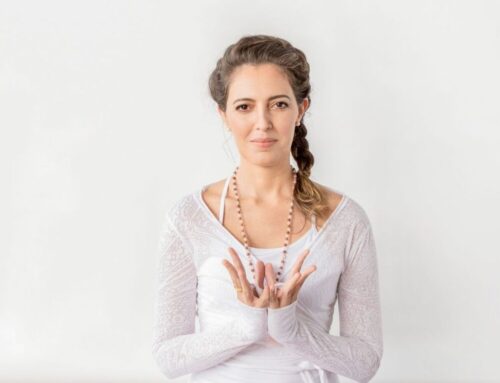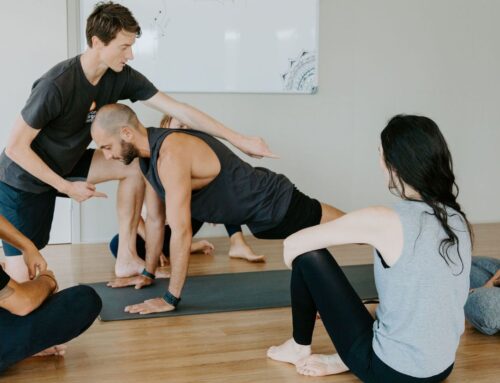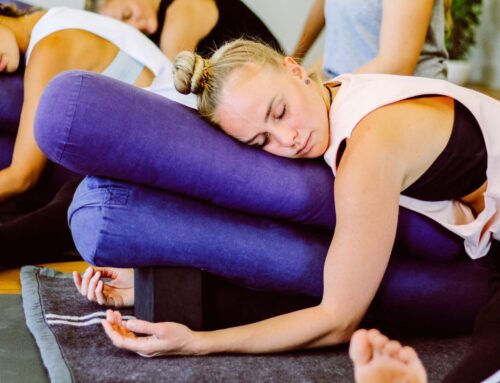These days, Restorative Yoga and Yin Yoga are bandied about as synonymous. Senior Bliss Baby Yoga teacher trainer, Jennifer Allen teaches both 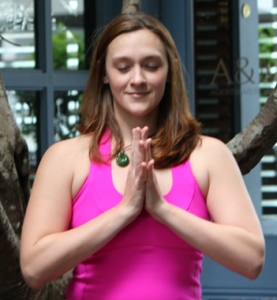 styles and helps clear up the confusion – they are in many ways two very different approaches to yoga. Read on to understand how.
styles and helps clear up the confusion – they are in many ways two very different approaches to yoga. Read on to understand how.
As yoga continues to grow in popularity on a global level, it’s becoming clear that to enjoy a successful career as a yoga teacher amidst the diverse ‘shopping-mart’ of yoga styles now on offer, we need to be well-versed in not just one but at least several different styles of practice. For me, it is reminiscent of my days as a professional dancer, when work opportunities would be limited unless you learnt to trade in your point shoes for tap shoes at any given moment! Now, as a full-time yoga teacher, I have found that I encounter the very same scenario – I have needed to diversify my skills. It’s not unusual for me to have to flow seamlessly from a 6pm dynamic, Vinyasa Flow class followed by a 7.30pm gentle, Restorative Yoga class. As a result, when asked that ubiquitous question – “what style of yoga do you teach?” – my answer has quickly become “it depends on the day!”
Under the umbrella of Hatha Yoga reside many different sub-branches of yoga that share a common lineage of postures and principles. The difference between these various hatha yoga sub-branches lies in the stylistic execution of the practice or the approach to the practice. The word ‘Hatha’ means a balancing of universal polarities. ‘Ha’ means ‘sun,’ ‘tha’ means ‘moon.’ Hatha Yoga therefore works to restore balance and equanimity in all aspects of the body, mind, breath and energetic space. The same Hatha principles that may be executed in a meticulously aligned and more static Iyengar Yoga practice, might flow more fluidly to music in a Vinyasa Yoga practice, or may be slowed right down and propped-up in a Restorative Yoga practice. The common thread woven through the core of all of these practices is: balance.
In response to the hustle and bustle of today’s society, with its prevalence of ‘busy-ness disease’, the need for an approach to yoga that focuses on balancing our ‘yang’ lifestyle is on the rise. Work stresses, traffic, parenting, keeping house, social expectations, and managing a busy calendar all contribute to the ‘yang’, or harder, more ‘masculine’ and more active aspects of our existence, leaving us with little, if any, time for quiet internalization. Therefore, the ‘yin’, or softer, more feminine, passive aspect in our life is left grossly out of balance.
Don’t get me wrong, there will always be a time and a place for the more dynamic, yang yoga practices – when the fire of our ‘tapas’, our austerity needs to be rekindled. However, balancing our yang approach to yoga with a practice that has qualities of yin is absolutely essential in restoring equanimity and therefore our health, wellbeing and vitality. There are two particular yin-balancing practices that are finding their way to just about every studio timetable, Restorative Yoga and Yin Yoga.
So often I am asked – “What is the difference between Restorative Yoga and Yin Yoga?” These practices may have aesthetic similarities to the naked eye, but in truth, the only thing that these practices have in common is their quality of yin- balancing. Their overall intention and execution are actually very different.
Restorative Yoga: the art of healing the nervous system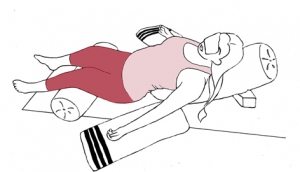
Based on the teachings of B.K.S Iyengar, Restorative Yoga at its core is a practice of passive healing. It is intended to carry the student into a deep state of relaxation by completely supporting the body in propped-up asanas, or postures. This allows the practitioner to surrender completely, allowing prana, or vital life energy, to bathe the body in nourishment. The kind of experience we are seeking when practicing restorative yoga is very subtle. The physical sensations the student should feel are minimal as the body finds space to gently open into the support of the props. This is unlike other styles of yoga where the student may be asked to use their breath as a coping mechanism for intense sensations as tight musculature begins to release. I like to remind my students during a Restorative practice that it is an act of doing, without doing. In other words, through the use of props as support, one is able to surrender completely any holding or tension in the body, exerting absolutely no effort in this process.
The physiological benefits of the practice are immeasurable. One of the major benefits of Restorative Yoga is the effect it has on the nervous system. The nervous system functions on two planes: sympathetic and parasympathetic. When the nervous system is in its plane of sympathetic function, the body enters its ‘fight or flight’ mode of survival. All of the systems of the body that are not needed for basic survival from say, running away from a saber-toothed tiger, temporarily cease functioning. Unfortunately, in today’s busy, stress-ridden society, more often than not, people are living prolonged periods of their daily life in their sympathetic nervous system! As a result, the body loses its ability to carry out basic daily functions, like proper respiration, digestion, and elimination. This concept causes me to ponder: did the caveman suffer irritable bowel syndrome, or just the high-powered businessman? Restorative Yoga, as its name would indicate, ‘restores’ the body to its long-term plane of parasympathetic nervous system function, the function of ‘rest and rejuvenate.’ It is in parasympathetic nervous system mode that the systems of the body can restore balance, allowing the body, breath, and in turn, the thinking mind and internal energetic space to heal and function at their highest potential.
With its balancing, healing qualities for the nervous system, Restorative yoga is therefore a panacea for every body! It also has many specialized applications, supporting those with conditions like anxiety, exhaustion, adrenal fatigue, chronic fatigue syndrome, hormonal imbalances and recovery from illness and surgery.
Yin Yoga: deep release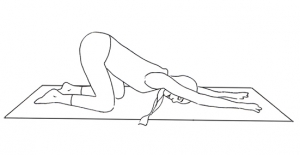
Introduced by Paul Grilley in the late 1980s, Yin Yoga is based on the ancient, Taoist concepts of yin and yang – the opposite and complementary principles in nature. It works synergistically with the principles of traditional Chinese medicine to shift ‘chi’ through the body – what we know in yoga as ‘prana.’ In this traditional context, the quality of ‘yin’ can be described as stable, sturdy, feminine, passive, cold, and downward moving. The quality of ‘yang’ is understood to be changing, mobile, masculine, active, hot, and upward moving. From a physiological perspective, the muscles of the body are more yang in quality – warm and pliable. Whereas, the bones, connective tissue, joints and fascial network of the musculature are said to be more yin, cold and rigid in quality. Yin Yoga works with these more immobile areas of the body to create a gradual, long-term release.
It is a myth that Yin Yoga is passive, as the length of time in postures combined with the intensity of sensation make this practice everything but! The yogi’s boundaries of patience will truly be tested as she employs the tools of gravity, time, and breath to unravel the tangled web of energetic blockage manifested in the form of physical tension.
In the average 75-90 minute Yin Yoga practice, only a handful of postures will be on offer. Each posture will be held for up to 5 minutes, depending on the surrounding joint space and its level of stabilization. For instance, classical Yin Yoga postures that open the area from the naval to the knees focus their attention on the hip joint, which has a deeper and more stable encapsulation. Yin poses that focus on opening the upper body focus on the shoulder joint, a much shallower and less stable joint space. We would need to hold these poses for less time to avoid over-loading the already fragile shoulder joint space. Most Yin Yoga poses are done supine (on the back), prone (on the belly), seated, or from tabletop, still allowing this practice to maintain its overall intention of grounding, and its quality of quiet internalization. Similar to restorative yoga, Yin Yoga postures sometimes use props, but very often they don’t involve any support at all.
Unlike Restorative Yoga, there may be a percentage of yogis for whom Yin Yoga is not appropriate. Pregnant women, for instance, need to be particularly mindful in Yin Yoga due to the strain it may put on their already vulnerable joints. Where the average yoga student may benefit from a healthy amount of strain on their joints through the gradual release of Yin postures, pregnant women carry a hormone called relaxin in their body throughout the entirety of their pregnancy and the period of breastfeeding, which when settling into their joints spaces, allows for a hypermobile range of motion to that joint. Additionally, anyone who is suffering from chronic or acute injury in or around a joint space could potentially do more harm than good if they overload that joint for a prolonged period of time. Lastly, yogis who experience hypermobility in their joints and therefore tend to ‘hang in their joints’ in a way that makes the joints vulnerable, could be adding insult to injury by taking the body into dangerous depths with a practice like Yin Yoga, stressing the ligamentous and connective tissue around the joints potentially to a breaking point.
I believe that both of these yin-balancing practices – Restorative Yoga and Yin Yoga – hold their own weight and value, and in terms of choosing a style of practice that suits your needs, it is important to remember that because of the differentiation in intention and execution of these practices, you may find that one may be more appropriate for you than the other. It is safe to say that Restorative Yoga is appropriate for EVERY BODY. If you have the ability to breathe, there will be an aspect of Restorative practice that will suit your needs, no matter how limited the body may be. However, this may not be entirely true for Yin Yoga.
In summary, Restorative Yoga and Yin Yoga both work in differing ways to restore balance to our lives by bringing us more into a natural state of ‘yin’, and in the crazy ‘yang’ world that we live in, the value of an hour and a half of self-nourishment, energetic healing, and quiet stillness is, well…priceless!
By Jennifer Allen (Bliss Baby Yoga International Senior Course Facilitator – Prenatal, Postnatal and Restorative Yoga).
Would you like to add Restorative Yoga to your teaching tool-belt? Join Bliss Baby Yoga Director and Founder, Ana Davis, for a Bliss Baby Yoga 1-Day Level 1 Restorative Teacher Training at Byron Yoga Retreat Centre, Saturday 7th May, 2016.
This 1-Day Restorative training is also available as an add-on to the Bliss Baby Yoga fully-residential 9-Day RPYT Prenatal and Postnatal Yoga Teacher Training intensive, 28th April – 6th May, 2016, at Byron Yoga Retreat Centre.
